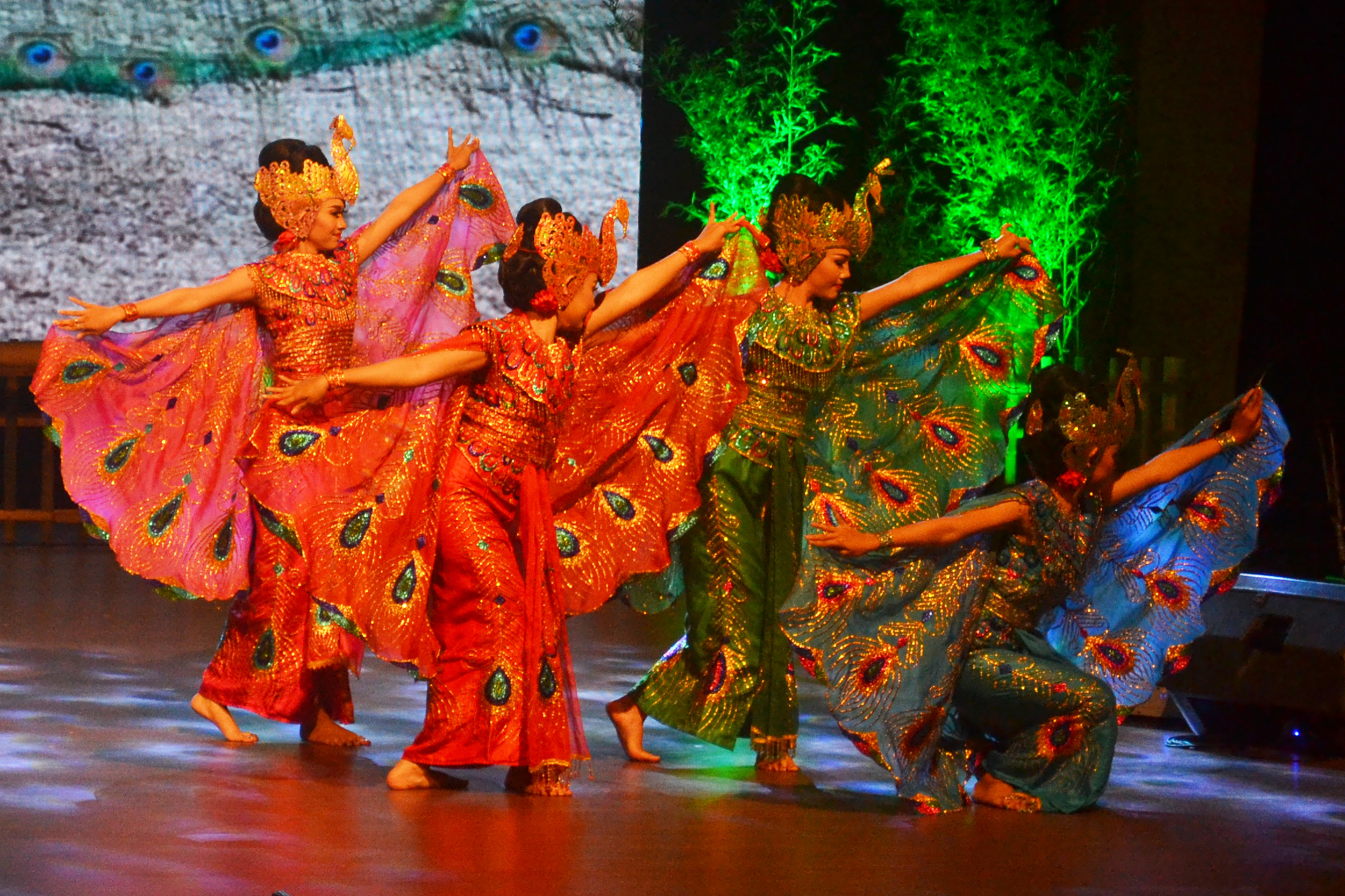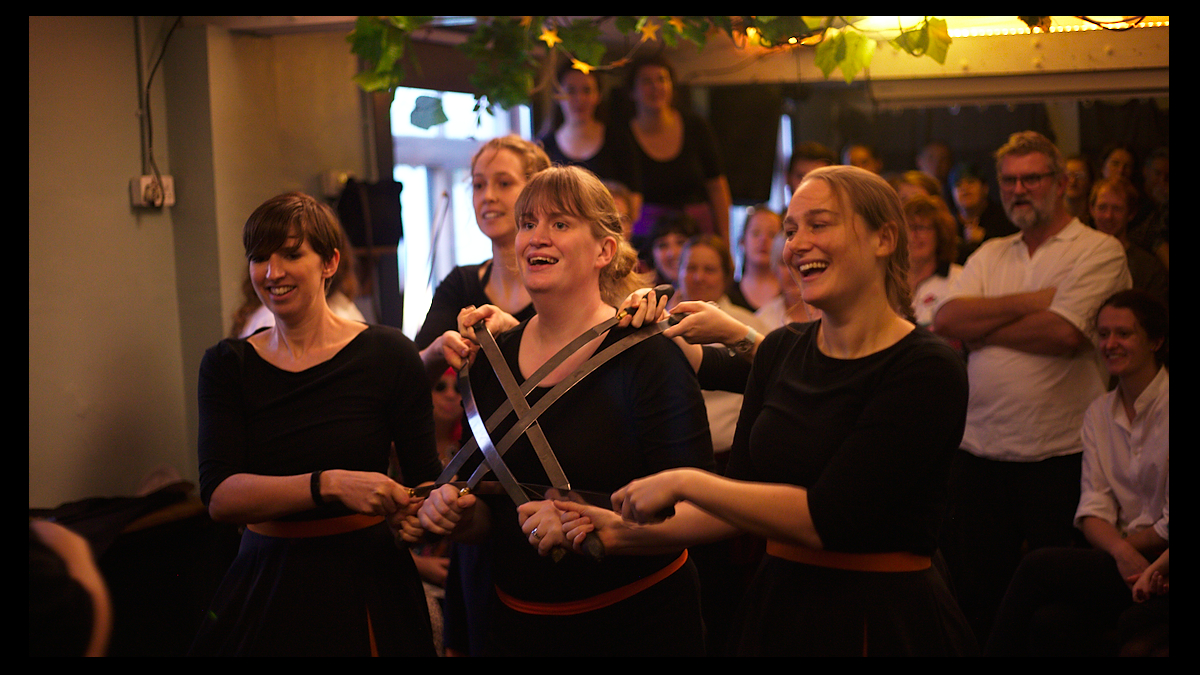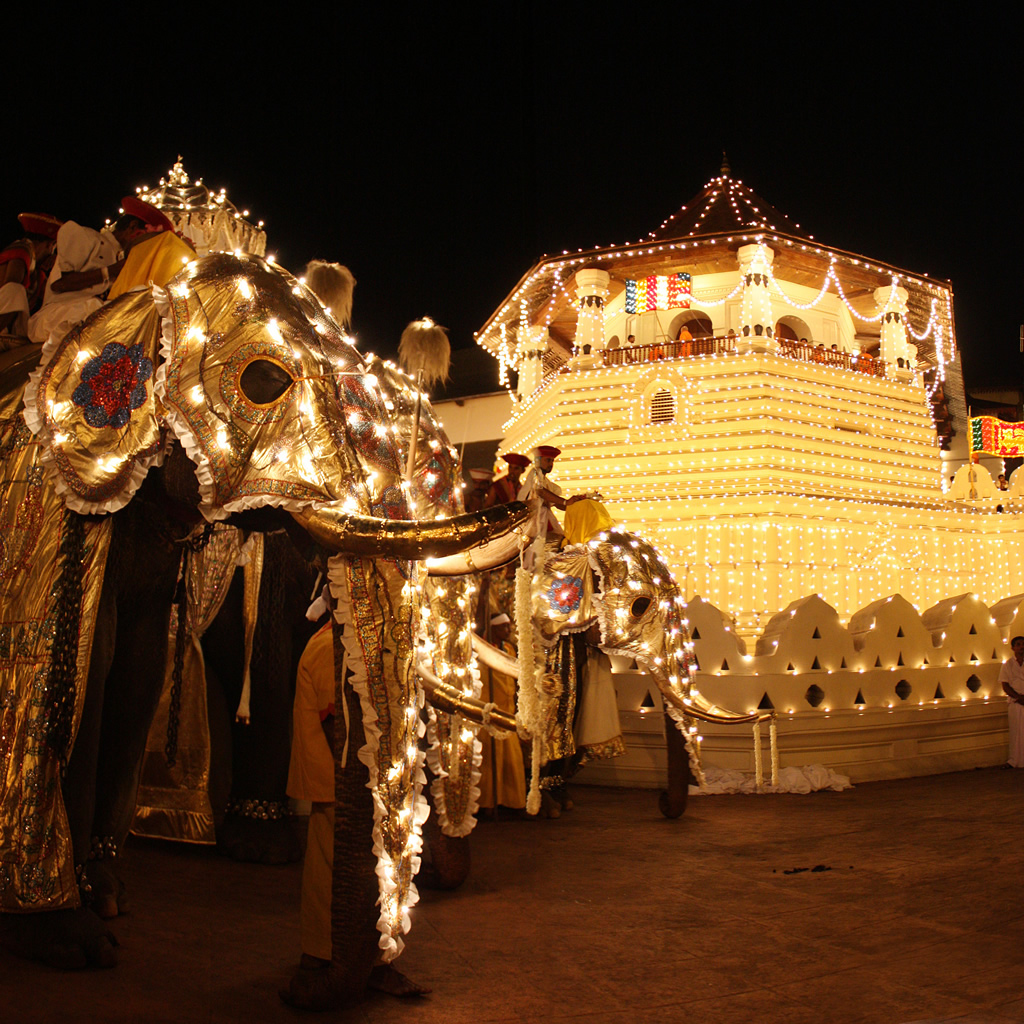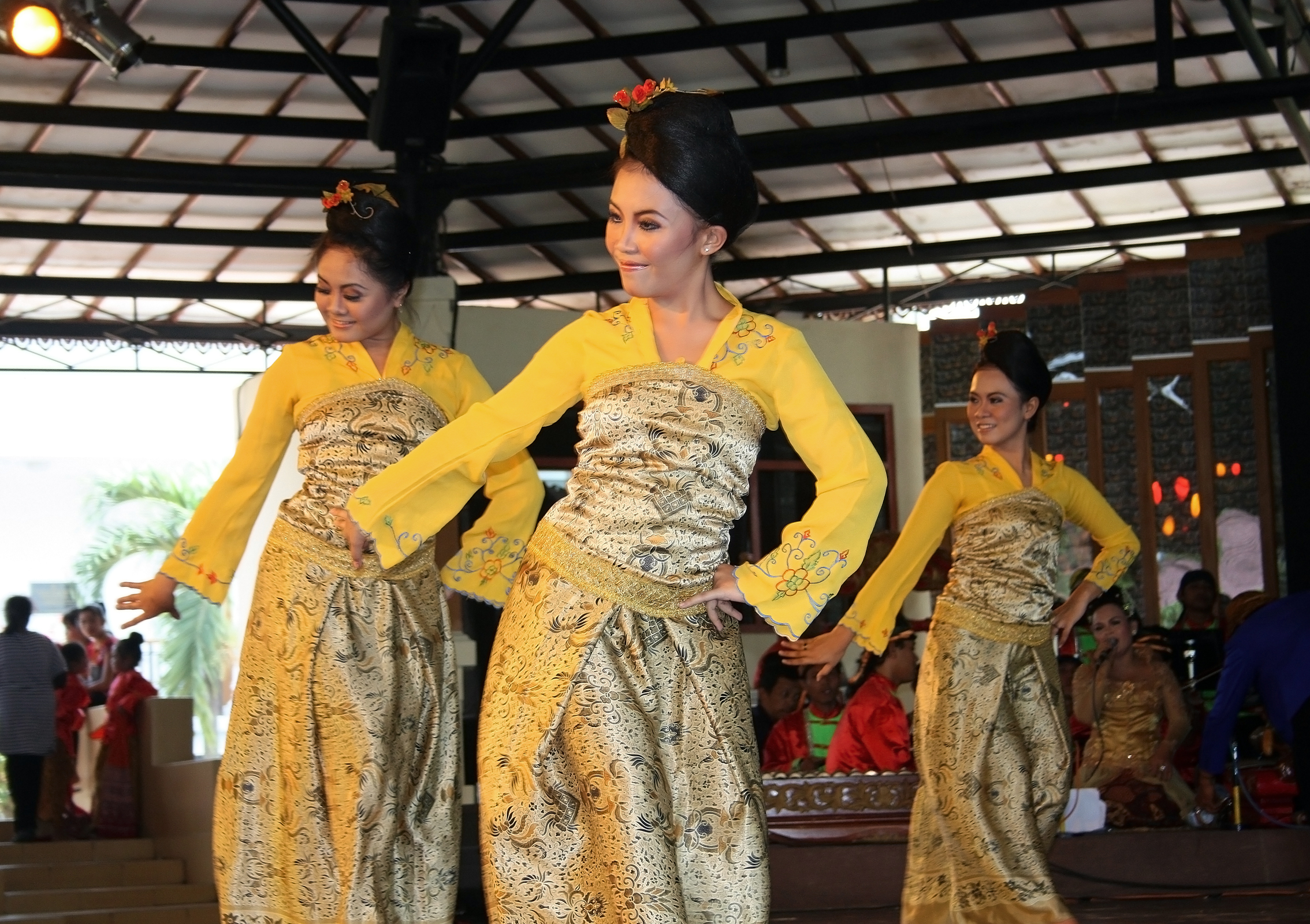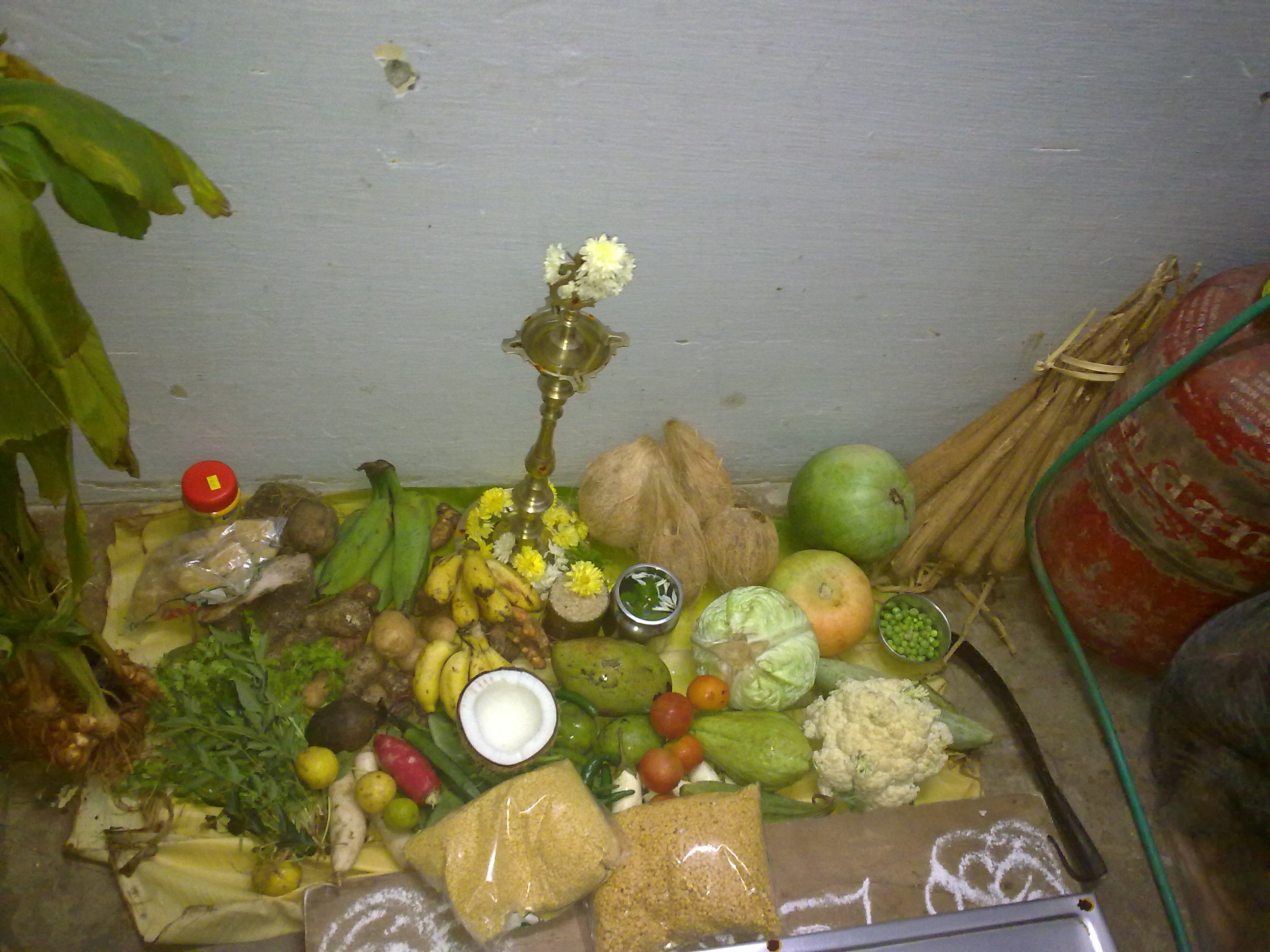|
Peacock Dance
The peacock dance or peafowl dance is a traditional Asian folk dance that describes the beauty and the movement of Peafowl, peacocks. There are several peacock dance traditions developed in Asia, including the peacock dances of Myanmar, of the western and northern parts of Cambodia, of West Java in Indonesia, and of the Indian subcontinent in Southern India, Sri Lanka, Bangladesh, and the Yunnan region of China China Peacock as a totem of the Dai people in the southwestern Chinese province Yunnan, one of the 56 ethnic groups in China, is an essential part of the cultural and spiritual aspects of the Dai people. The peacock dance as the most famous and traditional performance dance among the folk dances of the Dai people is prevalent in Ruili, Luxi located in Dehong Dai and Jingpo Autonomous Prefecture, Mengding, Mengda, Jinggu Dai and Yi Autonomous County, Cangyuan Va Autonomous County and other inhabitation regions of the Dai People. The peacock dance of the Dai ethnic group ha ... [...More Info...] [...Related Items...] OR: [Wikipedia] [Google] [Baidu] |
Folk Dance
A folk dance is a dance that reflects the life of the people of a certain country or region. Not all ethnic dances are folk dances. For example, Ritual, ritual dances or dances of ritual origin are not considered to be folk dances. Ritual dances are usually called "religious dances" because of their purpose. The terms "ethnic" and "traditional" are used when it is required to emphasize the cultural roots of the dance. In this sense, nearly all folk dances are ethnic ones. If some dances, such as polka, cross ethnic boundaries and even cross the boundary between "folk" and "ballroom dance", ethnic differences are often considerable enough to mention. Background Folk dances share some or all of the following attributes: *Dances are usually held at folk dance gatherings or social functions by people with little or no professional training, often to traditional music. *Dances not generally designed for public performance or the stage, though they may later be arranged and set for ... [...More Info...] [...Related Items...] OR: [Wikipedia] [Google] [Baidu] |
Water Festival
Water festivals are vibrant celebrations that occur across the globe, often marking the start of a new year or season. These festivals are deeply rooted in cultural and religious traditions, and they showcase the importance of water as a life-giving resource. In Asia, countries like Myanmar, Thailand, Laos, Cambodia, and the Xishuangbanna Prefecture and Dehong regions of China celebrate their respective new years with lively water festivals such as Songkran, Bunpimay, Thingyan, and Chaul Chnam Thmey. These festivities involve the joyous splashing of water, symbolizing purification and renewal. Beyond Southeast Asia and China, other countries have their own unique water-themed celebrations, from the Holi festival of colors in India to the Water Battle of Spain. These festivals serve as a reminder of the universal significance of water in our lives and our connection to it. For most Southeast Asian cultures, the festivities are a part of the broader South and Southeast Asian ... [...More Info...] [...Related Items...] OR: [Wikipedia] [Google] [Baidu] |
Perahara
The Kandy Esala Perahera (the Sri Dalada Perahara procession of Kandy) also known as The Festival of the Tooth is a festival held in July and August in Kandy, Sri Lanka. This historical procession is held annually to pay homage to the Sacred Tooth Relic of Buddha housed at the Sri Dalada Maligawa in Kandy. A unique symbol of Sri Lanka, the procession consists of traditional local dances such as fire dances and performances in whip-dance garments. The festival ends with the traditional ''Diya-kepeema'' ritual, a water cutting ceremony which is held at the Mahaweli River at Getambe, Kandy. History The Esala is believed to be a fusion of two separate but interconnected "''Peraheras''" (Processions) – The '' Esala'' and '' Dalada''. The Esala Perahera, which is thought to date back to the 3rd century BC, was a ritual enacted to request the gods for rainfall. The Dalada Perahera is believed to have begun when the Sacred Tooth Relic of Lord Buddha was brought to Sri Lanka from ... [...More Info...] [...Related Items...] OR: [Wikipedia] [Google] [Baidu] |
Sundanese Dance
Sundanese dances () is a dance tradition that is a part of ritual, artistic expression as well as entertainment and social conduct among the Sundanese people of West Java and Banten, Indonesia. Sundanese dance is usually cheerful, dynamic and expressive, with flowing movements in-sync with the beat of kendang accompanied with Gamelan degung music ensemble. In Sundanese culture the term ''ngibing'' means "to dance", but it is indeed performed in particular Sundanese style, usually performed between male and female couple. In West Java, all it takes is a woman's voice and a drum beat to make a man get up and dance. Every men there breach ordinary standards of decorum and succumb to the rhythm at village ceremonies or weddings. The music the men dance to varies from traditional gong degung ensembles to the contemporary pop known as dangdut, but they consistently dance with great enthusiasm. Henry Spiller in "Erotic Triangles" draws on decades of ethnographic research to explore the r ... [...More Info...] [...Related Items...] OR: [Wikipedia] [Google] [Baidu] |
Indonesia
Indonesia, officially the Republic of Indonesia, is a country in Southeast Asia and Oceania, between the Indian Ocean, Indian and Pacific Ocean, Pacific oceans. Comprising over List of islands of Indonesia, 17,000 islands, including Sumatra, Java, Sulawesi, and parts of Borneo and New Guinea, Indonesia is the world's largest archipelagic state and the List of countries and dependencies by area, 14th-largest country by area, at . With over 280 million people, Indonesia is the world's List of countries and dependencies by population, fourth-most-populous country and the most populous Islam by country, Muslim-majority country. Java, the world's List of islands by population, most populous island, is home to more than half of the country's population. Indonesia operates as a Presidential system, presidential republic with an elected People's Consultative Assembly, legislature and consists of Provinces of Indonesia, 38 provinces, nine of which have Autonomous administrative divisi ... [...More Info...] [...Related Items...] OR: [Wikipedia] [Google] [Baidu] |
DSC 0624 Yuri
DSC or Dsc may refer to: Education * Doctor of Science (D.Sc.) * District Selection Committee, an entrance exam in India * Doctor of Surgical Chiropody, superseded in the 1960s by Doctor of Podiatric Medicine Educational institutions * Dyal Singh College, Delhi, India * DSC International School, Hong Kong, China United States * Dalton State College, Georgia * Daytona State College, Florida * Deep Springs College, California * Dixie State College, now Utah Tech University, Utah Science and technology * Dice similarity coefficient, a statistical measure * Differential scanning calorimetry, or the differential scanning calorimeter * Digital setting circles, on telescopes * Digital still camera, a type of camera * Doppler shift compensation, in bat echolocation * Dye-sensitized solar cell, a low-cost solar cell * Dynamic stability control, computerized technology that improves a vehicle's stability * Dynamic susceptibility contrast, a technique in perfusion MRI * Subarctic cl ... [...More Info...] [...Related Items...] OR: [Wikipedia] [Google] [Baidu] |
Kerala
Kerala ( , ) is a States and union territories of India, state on the Malabar Coast of India. It was formed on 1 November 1956, following the passage of the States Reorganisation Act, by combining Malayalam-speaking regions of the erstwhile regions of Kingdom of Cochin, Cochin, Malabar District, Malabar, South Canara, and Travancore. Spread over , Kerala is the 14th List of states and union territories of India by area, smallest Indian state by area. It is bordered by Karnataka to the north and northeast, Tamil Nadu to the east and south, and the Laccadive Sea, Lakshadweep Sea to the west. With 33 million inhabitants as per the 2011 Census of India, 2011 census, Kerala is the List of states of India by population, 13th-largest Indian state by population. It is divided into 14 List of districts of Kerala, districts with the capital being Thiruvananthapuram. Malayalam is the most widely spoken language and is also the official language of the state. The Chera dynasty was the f ... [...More Info...] [...Related Items...] OR: [Wikipedia] [Google] [Baidu] |
Tamil Nadu
Tamil Nadu (; , TN) is the southernmost States and union territories of India, state of India. The List of states and union territories of India by area, tenth largest Indian state by area and the List of states and union territories of India by population, sixth largest by population, Tamil Nadu is the home of the Tamil people, who speak the Tamil language—the state's official language and one of the longest surviving Classical languages of India, classical languages of the world. The capital and largest city is Chennai. Located on the south-eastern coast of the Indian peninsula, Tamil Nadu is straddled by the Western Ghats and Deccan Plateau in the west, the Eastern Ghats in the north, the Eastern Coastal Plains lining the Bay of Bengal in the east, the Gulf of Mannar and the Palk Strait to the south-east, the Laccadive Sea at the southern Cape (geography), cape of the peninsula, with the river Kaveri bisecting the state. Politically, Tamil Nadu is bound by the Indian sta ... [...More Info...] [...Related Items...] OR: [Wikipedia] [Google] [Baidu] |
Thai Pongal
Pongal is a multi-day Hindu harvest festival celebrated by Tamils. The festival is celebrated over three or four days with Bhogi, Thai Pongal, Mattu Pongal and Kaanum Pongal, beginning on the last day of the Tamil calendar month of Margazhi, and observed on consecutive days. Thai Pongal is observed on the first day of the Tamil calendar month of Thai and usually falls on 14 or 15 January in the Gregorian calendar. It is dedicated to the solar deity Surya and corresponds to Makar Sankranti, the Hindu observance celebrated under various regional names across the Indian subcontinent. According to tradition, the festival marks the end of winter solstice, and the start of the Sun's six-month-long journey northwards called Uttarayana when the Sun enters Capricorn. The festival is named after the ceremonial "Pongal", which means "boiling over" or "overflow" in Tamil language and refers to the traditional dish prepared by boiling rice with milk and jaggery. Mattu Pongal is me ... [...More Info...] [...Related Items...] OR: [Wikipedia] [Google] [Baidu] |
Tamil Language
Tamil (, , , also written as ''Tamizhil'' according to linguistic pronunciation) is a Dravidian language natively spoken by the Tamil people of South Asia. It is one of the longest-surviving classical languages in the world,. "Tamil is one of the two longest-surviving classical languages in India" (p. 7). attested since 300 BC, 300 BCE.: "...the most acceptable periodisation which has so far been suggested for the development of Tamil writing seems to me to be that of A Chidambaranatha Chettiar (1907–1967): 1. Sangam Literature – 200BC to AD 200; 2. Post Sangam literature – AD 200 – AD 600; 3. Early Medieval literature – AD 600 to AD 1200; 4. Later Medieval literature – AD 1200 to AD 1800; 5. Pre-Modern literature – AD 1800 to 1900" at p. 610 Tamil was the lingua franca for early maritime traders in South India, with Tamil inscriptions found outside of the Indian subcontinent, such as Indonesia, Thailand, and Egypt. The language has a well-documented history wit ... [...More Info...] [...Related Items...] OR: [Wikipedia] [Google] [Baidu] |
Mayilattam
Mayilattam is an artistic and religious form of dance performed in the Hindu temples of Tamil Nadu and Kerala in reverence to Murugan, a regional form of the Hindu deity Kartikeya Kartikeya (/Sanskrit phonology, kɑɾt̪ɪkejə/; ), also known as Skanda (Sanskrit phonology, /skən̪d̪ə/), Subrahmanya (/Sanskrit phonology, sʊbɾəɦməɲjə/, /ɕʊ-/), Shanmukha (Sanskrit phonology, /ɕɑnmʊkʰə/) and Murugan .... Literally translating as the "peacock dance", the performers seat themselves upon a peacock replica, which is the mount of the deity. Description Mayilattam performers wear costumes from head to toe with headdresses and peacock feathers, that can be opened and closed using a thread, and perform specific dances. The performers dance on a tall piece of wood attached at the end of their feet. This dance is performed in all Murugan temples as a tradition during festivals. The number of Mayilattam performers is decreasing due to financial reasons. The Mayi ... [...More Info...] [...Related Items...] OR: [Wikipedia] [Google] [Baidu] |
